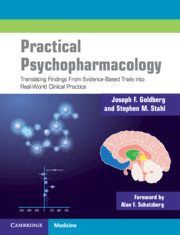 Practical Psychopharmacology
Practical Psychopharmacology Book contents
- Practical Psychopharmacology
- Practical Psychopharmacology
- Copyright page
- Dedication
- Contents
- Foreword
- Preface
- Abbreviations
- Part I General Principles
- Part II Targets of Pharmacotherapy
- 13 Disordered Mood and Affect
- 14 Disorders of Impulsivity, Compulsivity, and Aggression
- 15 Psychosis
- 16 Deficit States and Negative Symptoms
- 17 Anxiety
- 18 Addiction and the Reward Pathway
- 19 Trauma and Post-traumatic Stress Disorder
- 20 Personality Disorders and Traits
- 21 Cognition
- 22 Putting It All Together
- References
- Index
13 - Disordered Mood and Affect
from Part II - Targets of Pharmacotherapy
Published online by Cambridge University Press: 19 October 2021
- Practical Psychopharmacology
- Practical Psychopharmacology
- Copyright page
- Dedication
- Contents
- Foreword
- Preface
- Abbreviations
- Part I General Principles
- Part II Targets of Pharmacotherapy
- 13 Disordered Mood and Affect
- 14 Disorders of Impulsivity, Compulsivity, and Aggression
- 15 Psychosis
- 16 Deficit States and Negative Symptoms
- 17 Anxiety
- 18 Addiction and the Reward Pathway
- 19 Trauma and Post-traumatic Stress Disorder
- 20 Personality Disorders and Traits
- 21 Cognition
- 22 Putting It All Together
- References
- Index
Summary
Younger readers may not appreciate that prior to DSM-IV, the phenomena that we today call “mood disorders” were identified more precisely as affective disorders, denoting a fundamental distinction between disturbances of mood (the subjective experience of emotion) and affect (the objective behavioral expression of mood). Given that problems with “mood” are ubiquitous throughout virtually all aspects of psychopathology, links between the signs and symptoms of “mood problems” are critical both to nosological classification and to identifying targets of pharmacotherapy interventions. Features associated with affective disorders encompass problems with energy, the sleep–wake cycle, thinking and perception, impulse control, cognition (e.g., attentional processing, problem-solving), motivation/arousal, and eating behaviors, among others.
In this chapter, we present information about the treatment of mood/affective disorders as a broad overarching category, with subdistinctions (such as polarity) highlighted as clinical descriptors, rather than as fundamentally different illnesses. This may trouble some readers. Yet, one could slice the affective pie innumerable ways.
- Type
- Chapter
- Information
- Practical PsychopharmacologyTranslating Findings From Evidence-Based Trials into Real-World Clinical Practice, pp. 281 - 332Publisher: Cambridge University PressPrint publication year: 2021
